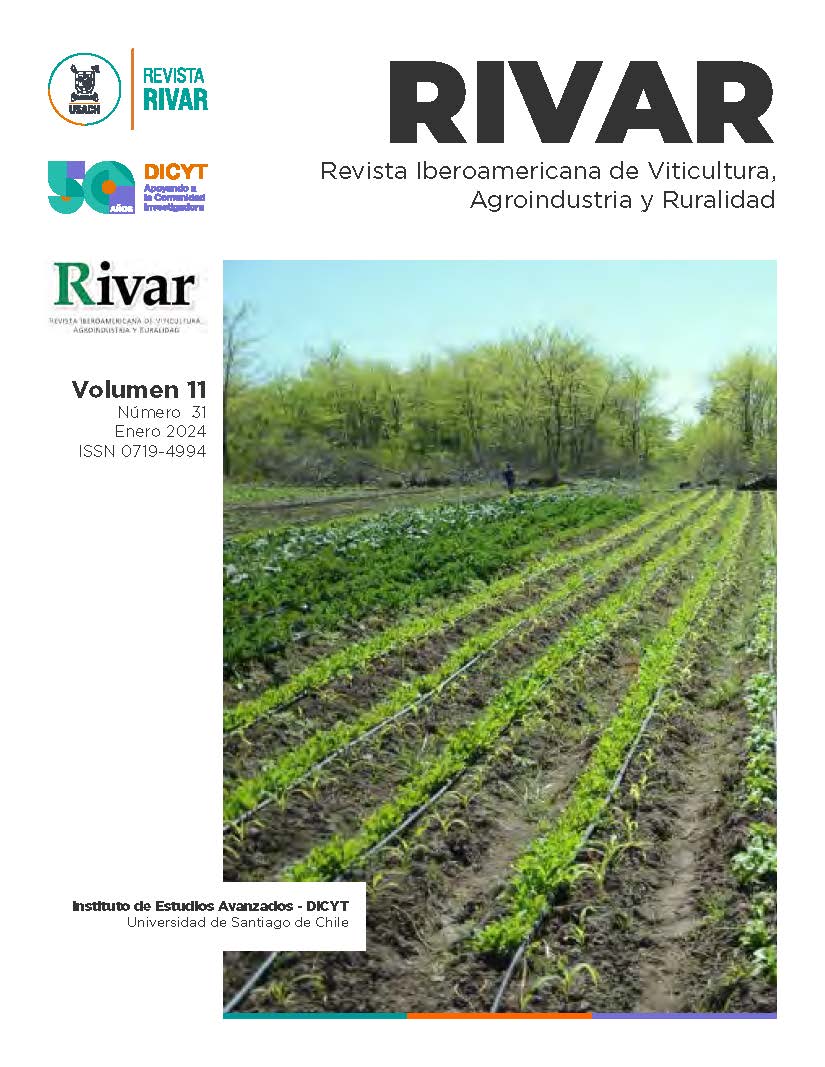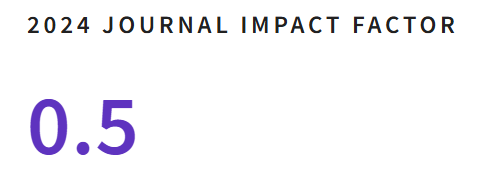Use of Maize (Zea mays) Residues in the Industry: Bibliographical Review
DOI:
https://doi.org/10.35588/rivar.v10i31.5980Keywords:
agroindustry, environment, biomass, resource management, recyclingAbstract
The use of organic waste is a strategy that has gained impact in favor of the environment, especially among agro-industrial companies. Waste from the food industry contains structural components, such as lignocellulose, which can be used in different areas. In this sense, this work is a qualitative systematic review of research based on diverse databases in which the use of corn residues is sought. For greater specificity in the search for information, the Boolean AND operator was used and key terms, prioritizing research carried out between 2018 and 2023. Through the bibliographic analysis, eight areas were identified in which corn residues are used: bioremediation, feeding, energy, lignocellulose splitting, biopolymers, characterization, and construction. Of these, most investigations refer to bioremediation (30.58%). In addition, of the residues used, the one with the greatest utility is stubble (44.44%), followed using stems (16.67%) and rachis (16.67%). Regarding agribusiness, the use of corn residues poses a promising future, with emphasis on the production of paper packaging, biopolymers, and food additives.
Downloads
References
Amer, M.W., Aljariri Alhesan, J.S., Ibrahim, S., Qussay, G., Marshall, M. y Al-Ayed, O.S. (2021). Potential Use of Corn Leaf Waste for Biofuel Production in Jordan (Physio-chemical Study). Energy, 214, 118863. https://doi.org/10.1016/j.energy.2020.118863
Astudillo, S., Vera, L., Astudillo, J. y Castro, C. (2020). Evaluación del poder biosorbente de la hoja de maíz en la remoción de metales pesados. Afinidad: Revista de Química Teórica y Aplicada, 77(591), 182-188.
Campos Silva, J., Jayane Nunes Siqueira, A., Bezerra Maia, H. y Rachide Nunes, R. (2021). Vermicomposting Corn Waste under Cultural and Climatic Conditions of the Brazilian Backwoods. Bioresource Technology Reports, 15, 100730. https://doi.org/10.1016/j.biteb.2021.100730
Cardoso, J., Nava, D. y Guzmán, G. (2018). Sistema de almacenamiento de energía y el uso de biopolímeros electrolitos. Contactos, Revista de Educación en Ciencias e Ingeniería, 110, 61-67.
Cong, L., Tian, G., Luo, D., Ren, X. y Xiang, X. (2020). Hydrothermally Assisted Transformation of Corn Stalk Wastes into High-performance Hard Carbon Anode for Sodium-ion Batteries. Journal of Electroanalytical Chemistry, 871, 114249. https://doi.org/10.1016/j.jelechem.2020.114249
Espinosa, R.V., Soto, M., Garcia, M.V. y Naranjo, J.E. (2021). Challenges of Implementing Cleaner Production Strategies in the Food and Beverage Industry: Literature Review en M. V. García, F. Fernández-Peña y C. Gordón-Gallegos (Eds.), Advances and Applications in Computer Science, Electronics and Industrial Engineering. Advances in Intelligent Systems and Computing (Vol. 1307, pp. 121-133). Springer. https://doi.org/10.1007/978-981-33-4565-2_8
Gao, M., Zou, H., Tian, W., Shi, D., Chai, H., Gu, L., He, Q. y Tang, W.Z. (2021). Co-digestive Performance of Food Waste and Hydrothermal Pretreated Corn Cob. Science of The Total Environment, 768, 144448. https://doi.org/10.1016/j.scitotenv.2020.144448
García, J.S. (2022). Aprovechamiento y revalorización de un residuo proteico del maíz como estabilizante de productos alimentarios. [Tesis de doctorado]. Universidad de Sevilla.
Guin, P.J., Bhardwaj, Y.K. y Varshney, L. (2018). Radiation Grafting: A Voyage from Bio-waste Corn Husk to an Efficient Thermostable Adsorbent. Carbohydrate Polymers, 183, 151-164. https://doi.org/10.1016/j.carbpol.2017.11.101
Kamarudin, N.H., Harun, Z., Othman, M.H.D., Abdullahi, T., Syamsul Bahri, S., Yunos, M.Z. y Wan Salleh, W.N. (2020). Waste Environmental Sources of Metakaolin and Corn Cob Ash for Preparation and Characterisation of Green Ceramic Hollow Fibre Membrane (h-MCa) for oil-Water Separation. Ceramics International, 46(2), 1512-1525. https://doi.org/10.1016/j.ceramint.2019.09.118
Lahori, A.H., Guo, Z., Zhang, Z., Li, R., Mahar, A., Awasthi, M. K., Shen, F., Sial, T.A., Kumbhar, F., Wang, P. y Jiang, S. (2017). Use of Biochar as an Amendment for Remediation of Heavy Metal-Contaminated Soils: Prospects and Challenges. Pedosphere, 27(6), 991-1014. https://doi.org/10.1016/S1002-0160(17)60490-9
Laiño, A.S. (2021). Ensilaje de rastrojo de maíz asociado con diferentes niveles de urea y melaza para la alimentación de rumiantes. Caracterización y posicionamiento estratégico. [Tesis de doctorado]. Universidad de Córdoba.
Li, Y., Song, X., Xu, W., Duan, X., Shi, J. y Li, X. (2022). Preparation of Biomass Film from Waste Biomass Energy Corn Stalk under Carbon Neutralization Strategy. Materials Today Communications, 32, 104001. https://doi.org/10.1016/j.mtcomm.2022.104001
Liew, C.W. y Ramesh, S. (2015). Electrical, Structural, Thermal and Electrochemical Properties of Corn Starch-based Biopolymer Electrolytes. Carbohydrate Polymers, 124, 222-228. https://doi.org/10.1016/j.carbpol.2015.02.024
Linares Castañeda, A., Corzo Ríos, L.J., Bautista Ramírez, E. y Gómez, Y.M. (2021). Elaboración de un envase primario para alimentos a partir de residuos de maíz y piñón mexicano. TIP Revista Especializada en Ciencias Químico-Biológicas, 24(1), 1-15.
Liu, X., Li, C., He, R. y Yang, Q. (27-29 de mayo de 2011). The Study and Application of Corn Straw Organic Growing Substrate in Ornamental Nurseries en 2011 International Conference on New Technology of Agricultural (pp. 212-215). Zibo, China. https://doi.org/10.1109/ICAE.2011.5943786
Liu, Y., Lv, X., Bao, J., Xie, J., Tang, X., Che, J., Ma, Y. y Tong, J. (2019). Characterization of Silane Treated and Untreated Natural Cellulosic Fibre from Corn Stalk Waste as Potential Reinforcement in Polymer Composites. Carbohydrate Polymers, 218, 179-187. https://doi.org/10.1016/j.carbpol.2019.04.088
Luo, G., Wang, W., Xie, W., Tang, Y., Xu, Y. y Wang, K. (2022). Co-pyrolysis of Corn Stover and Waste Tire: Pyrolysis Behavior and Kinetic Study Based on Fraser-Suzuki Deconvolution Procedure. Journal of Analytical and Applied Pyrolysis, 168, 105743. https://doi.org/10.1016/j.jaap.2022.105743
Ma, D., Zhu, B., Cao, B., Wang, J. y Zhang, J. (2017). Fabrication of the Novel Hydrogel Based on Waste Corn Stalk for Removal of Methylene Blue Dye from Aqueous Solution. Applied Surface Science, 422, 944-952. https://doi.org/10.1016/j.apsusc.2017.06.072
Ma, Z., Yao, J., Wang, Y., Jia, J., Liu, F. y Liu, X. (2022). Polysaccharide-based Delivery System for Curcumin: Fabrication and Characterization of Carboxymethylated Corn Fiber Gum/Chitosan Biopolymer Particles. Food Hydrocolloids, 125, 107367. https://doi.org/10.1016/j.foodhyd.2021.107367
Nurhayati, A.Y., Hariadi, Y.C. y Hasanah, W. (2016). Endeavoring to Food Sustainability by Promoting Corn Cob and Rice Husk Briquetting to Fuel Energy for Small Scale Industries and Household Communities. Agriculture and Agricultural Science Procedia, 9, 386-395. https://doi.org/10.1016/j.aaspro.2016.02.154
Peña-Gómez, N., Panagopoulos, V., Kanellaki, M., Koutinas, A.A., Ruiz-Rico, M., Fernández-Segovia, I. y Barat, J.M. (2020). Non-thermal Treatment for the Stabilisation of Liquid Food Using a Tubular Cellulose Filter from Corn Stalks. Food Control, 112, 107164. https://doi.org/10.1016/j.foodcont.2020.107164
Ramírez, J.B.V. y García, J.N.A. (2021). Comportamiento mecánico del adoquín de hormigón adicionando residuos orgánicos del maíz. Dominio de las Ciencias, 7(5), 148-168.
Sharma, N., Sharma, P. y Parashar, A.K. (2022). Incorporation of Silica Fume and Waste Corn Cob Ash in Cement and Concrete for Sustainable Environment. Materials Today: Proceedings, 62, 4151-4155. https://doi.org/10.1016/j.matpr.2022.04.677
Srivastava, N., Singh, R., Mohammad, A., Pal, D.B., Ahmad, I., Alam, M.M., Mishra, P.K. y Gupta, V. K. (2022). Acid Tolerant Multicomponent Bacterial Enzymes Production Enhancement under the Influence of Corn Cob Waste Substrate. International Journal of Food Microbiology, 373, 109698. https://doi.org/10.1016/j.ijfoodmicro.2022.109698
Treviño, J., Hernández, M.T. y Caballero, R. (2011). Estudio del valor nutritivo de las hojas y tallo del maíz híbrido de tallo azucarado. Pastos: Revista de la Sociedad Española para el Estudio de los Pastos, 4(2), 286-292.
Vinueza Cisneros, B.S. (2020). Composición química de residuos agroindustriales del maíz (Zea mays) (Cáscara, Pelusa, Tusa y Panca) utilizados en la alimentación de rumiantes. [Tesis de pregrado]. Universidad Técnica Estatal de Quevedo.
Wang, H., Zhen, Z., Yao, S. y Li, S. (2022a). Synthesis of High Acid-resistant Iltramarine Blue Pigment through Coal Gangue, Industrial Zeolite Waste and Corn Straw Waste Recycling. Resources Chemicals and Materials, 1(2), 137-145. https://doi.org/10.1016/j.recm.2022.03.003
Wang, W., Yang, D., Mou, L., Wu, M., Wang, Y., Tan, F. y Yang, F. (2022b). Remodeling of Waste Corn Stalks into Renewable, Compressible and Hydrophobic Biomass-based Aerogel for Efficient and Selective Oil/organic Solvent Absorption. Colloids and Surfaces A: Physicochemical and Engineering Aspects, 645, 128940. https://doi.org/10.1016/j.colsurfa.2022.128940
Wilaipon, P., Fung, C.C. y Nayar, C. (28-31 de octubre de 2002). A Study on the Potential of Corn Cob Engine-generator for Electricity Generation in Thailand en 2002 IEEE Region 10 Conference on Computers, Communications, Control and Power Engineering. TENCOM ’02. Proceedings. Beijing, China. https://doi.org/10.1109/TENCON.2002.1182722
Xia, X., Liang, Y., Lan, S., Li, X., Xie, Y. y Yuan, W. (2018). Production and Flocculating Properties of a Compound Biopolymer Flocculant from Corn Ethanol Wastewater. Bioresource Technology, 247, 924-929. https://doi.org/10.1016/j.biortech.2017.10.003
Xing, B.S., Cao, S., Han, Y., Wang, X. C., Wen, J. y Zhang, K. (2020). A Comparative Study of Artificial Cow and Sheep Rumen Fermentation of Corn Straw and Food Waste: Batch and Continuous Operation. Science of The Total Environment, 745, 140731. https://doi.org/10.1016/j.scitotenv.2020.140731
Xu, C., Zhao, J., Yang, W., He, L., Wei, W., Tan, X., Wang, J. y Lin, A. (2020). Evaluation of Biochar Pyrolyzed from Kitchen Waste, Corn Straw, and Peanut Hulls on Immobilization of Pb and Cd in Contaminated Soil. Environmental Pollution, 261, 114133. https://doi.org/10.1016/j.envpol.2020.114133
Xu, J., Cheng, W., Inglett, G. E., Wu, P., Kim, S., Liu, S. X. y Tseng, Y. (2010). Micro-heterogeneity of Cellulosic Fiber Biopolymer Prepared from Corn Hulls. LWT Food Science and Technology, 43(6), 977-981. https://doi.org/10.1016/j.lwt.2010.02.008
Yadav, M.P., Hicks, K.B., Johnston, D.B., Hotchkiss, A.T., Chau, H.K. y Hanah, K. (2016). Production of Bio-based Fiber Gums from the Waste Streams Resulting from the Commercial Processing of Corn Bran and Oat Hulls. Food Hydrocolloids, 53, 125-133. https://doi.org/10.1016/j.foodhyd.2015.02.017
You, Z., Pan, S.Y., Sun, N., Kim, H. y Chiang, P.C. (2019). Enhanced Corn-stover Fermentation for Biogas Production by NaOH Pretreatment with CaO Additive and Ultrasound. Journal of Cleaner Production, 238, 117813. https://doi.org/10.1016/j.jclepro.2019.117813
Zahoor, Wang, W., Tan, X., Guo, Y., Zhang, B., Chen, X., Yu, Q., Zhuang, X. y Yuan, Z. (2021). Mild Urea/KOH Pretreatment to Enhance Enzymatic Hydrolysis of Corn Stover with Liquid Waste Recovery for Plant Growth. Journal of Cleaner Production, 284, 125392. https://doi.org/10.1016/j.jclepro.2020.125392
Zambrano Mendoza, J.L. y Caviedes, M. (2022). Estado actual de la producción de maíz en Ecuador. INIAP-EESC.









